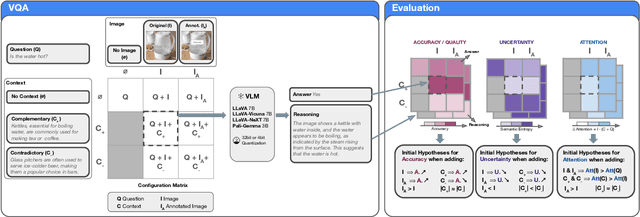Why context matters in VQA and Reasoning: Semantic interventions for VLM input modalities
Paper and Code
Oct 02, 2024



The various limitations of Generative AI, such as hallucinations and model failures, have made it crucial to understand the role of different modalities in Visual Language Model (VLM) predictions. Our work investigates how the integration of information from image and text modalities influences the performance and behavior of VLMs in visual question answering (VQA) and reasoning tasks. We measure this effect through answer accuracy, reasoning quality, model uncertainty, and modality relevance. We study the interplay between text and image modalities in different configurations where visual content is essential for solving the VQA task. Our contributions include (1) the Semantic Interventions (SI)-VQA dataset, (2) a benchmark study of various VLM architectures under different modality configurations, and (3) the Interactive Semantic Interventions (ISI) tool. The SI-VQA dataset serves as the foundation for the benchmark, while the ISI tool provides an interface to test and apply semantic interventions in image and text inputs, enabling more fine-grained analysis. Our results show that complementary information between modalities improves answer and reasoning quality, while contradictory information harms model performance and confidence. Image text annotations have minimal impact on accuracy and uncertainty, slightly increasing image relevance. Attention analysis confirms the dominant role of image inputs over text in VQA tasks. In this study, we evaluate state-of-the-art VLMs that allow us to extract attention coefficients for each modality. A key finding is PaliGemma's harmful overconfidence, which poses a higher risk of silent failures compared to the LLaVA models. This work sets the foundation for rigorous analysis of modality integration, supported by datasets specifically designed for this purpose.
 Add to Chrome
Add to Chrome Add to Firefox
Add to Firefox Add to Edge
Add to Edge